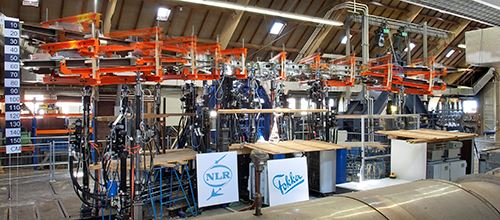TAPAS 2: Next steps in thermoplastic aerostructures
The Netherland's-based Thermoplastic Affordable Primary Aircraft Structure (TAPAS) consortium's TAPAS 2 team builds on the successes of TAPAS 1, taking the next steps in aircraft thermoplastic composites architecture.
The Thermoplastic Affordable Primary Aircraft Structure (TAPAS) consortium was launched in The Netherlands in 2009 with the goal of developing new thermoplastic composite materials and processes for use in Airbus (Toulouse, France) aerostructures. The consortium is starting its second phase of application and material development, and its members hope, by 2017, to bring to market a thermoplastic composite fuselage and torsion-box concept that proves the viability of thermoplastics in commercial aerostructures.
In addition to Airbus, the TAPAS consortium comprises a number of composite material suppliers, composite parts manufacturers and academic research institutions based in The Netherlands. They include project lead Fokker Aerostructures (Hoogeveen), the Airborne Technology Center and Kok & Van Engelen (both based in The Hague), Dutch Thermoplastic Components (Alkmaar), Technobis Fibre Technologies (Uitgeest), TenCate Advanced Composites (Nijverdal), KE-works, CoDeT and Technische Universiteit Delft (all based in Delft), the University of Twente (Enschede) and the National Aerospace Laboratory, in Amsterdam.
Arnt Offringa, director R&D at Fokker, says that under the first phase of the program, called TAPAS 1, the consortium was asked by Airbus to investigate the use of thermoplastic composites (TPCs) in an aircraft fuselage structure. Fokker added torsion boxes (typically tails and/or wings) as another application area. Material used was a new TenCate unidirectional carbon fiber prepreg with Hexcel (Stamford, Conn.) AS4 fibers and Arkema (Colombes, France) polyetherketoneketone (PEKK) matrix. Processes used were automated fiber placement, press forming and welding.
Offringa says the result, unveiled in 2013, was a demonstrator fuselage panel of technology readiness level (TRL) 3 and a 12m/39-ft torsion box for a tail structure of TRL 5. (Maximum TRL is 9, which means the part or structure is fully tested and operational.) Test results for the structure, he says, were encouraging. The TPC parts showed 10 percent weight savings compared to thermoset materials, primarily because the thermoplastic’s inherent toughness better prevents crack propagation and, therefore, allows the use of thinner laminates. Further, the stiffener and skin designs were segregated, which increased design freedom and promoted weight optimization.
Consortium signatories forged the contract for TAPAS 2 on Jan. 20, this year. Currently in launch mode, the TAPAS 2 consortium is taking both of the TAPAS 1 structures further up the TRL scale. Offringa says “the technology is very promising and worthwhile” and is confident that thermoplastics will continue to prove feasible in commercial aerospace.
For the torsion box, he says, the goals include generating allowables, qualifying materials and processes, developing a “wet” box that can contain fuel and using a part architecture that features beams welded to skin. Offringa says TAPAS 2 hopes to have the technology for a dry box at TRL 6 by the end of 2015, and several airframers have expressed interest in real-world applications of the technology.
The fuselage panel, it’s hoped, will be matured to TRL 4 by 2017. The fuselage panel challenge, says Offringa, is managing skin thickness, particularly for single-aisle craft the size of an Airbus A320 or a Boeing 737. “These laminates are relatively thin,” he notes. “Design based on loading is thin, but local loads — for hail strike or maintenance tool impact — can cause a thickness increase. For these thin structures, a tough material will fare better. But the real question is, ‘How thin a skin can we get that will comply with all requirements?’”
In the long term, the hope is that TPCs can be proven a viable option for the successor to a narrow-body program. Offringa says that in addition to TPC, Airbus is considering and looking closely at aluminum and thermoset prepregs.
About 60 percent of TAPAS 2’s €24 million budget will come from consortium partners, with the Dutch government providing the balance in the form of “risk-free” loans (e.g., the Netherlands Ministry of Economic Affairs is supporting the ongoing partnership with a loan of €9.5 million). When revenue is derived from the project, the loans will be repaid to the Dutch government.
Related Content
Collins Aerospace demonstrates new thermoplastic composites capabilities
Collins Aerospace in Almere has produced a 7-meter raceway for the Clean Sky 2 MFFD lower fuselage using novel CCM and tooling technology while the Riverside facility in the U.S. advances AFP and welding as part of global strategy for more sustainable airframes.
Read MorePlant tour: National Institute for Aviation Research, Wichita, Kan., U.S.
NIAR, located at Wichita State University in the heart of the American aerospace manufacturing industry, has evolved to become a premier hub of teaching, R&D, creativity and innovation.
Read MoreCFRTP upper stage propellant tank
PROCOMP uses in-situ consolidation AFP and ultrasonic welding to demonstrate lightweight, novel tank design.
Read MoreProtecting EV motors more efficiently
Motors for electric vehicles are expected to benefit from Trelleborg’s thermoplastic composite rotor sleeve design, which advances materials and processes to produce a lightweight, energy-efficient component.
Read MoreRead Next
CW’s 2024 Top Shops survey offers new approach to benchmarking
Respondents that complete the survey by April 30, 2024, have the chance to be recognized as an honoree.
Read MoreComposites end markets: Energy (2024)
Composites are used widely in oil/gas, wind and other renewable energy applications. Despite market challenges, growth potential and innovation for composites continue.
Read MoreFrom the CW Archives: The tale of the thermoplastic cryotank
In 2006, guest columnist Bob Hartunian related the story of his efforts two decades prior, while at McDonnell Douglas, to develop a thermoplastic composite crytank for hydrogen storage. He learned a lot of lessons.
Read More















.jpg;maxWidth=300;quality=90)












